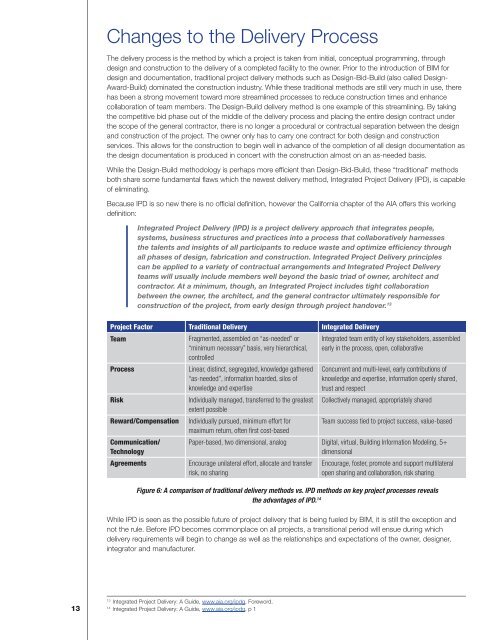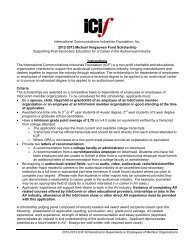Building Information Modeling (BIM) - InfoComm International
Building Information Modeling (BIM) - InfoComm International
Building Information Modeling (BIM) - InfoComm International
You also want an ePaper? Increase the reach of your titles
YUMPU automatically turns print PDFs into web optimized ePapers that Google loves.
13<br />
Changes to the Delivery Process<br />
The delivery process is the method by which a project is taken from initial, conceptual programming, through<br />
design and construction to the delivery of a completed facility to the owner. Prior to the introduction of <strong>BIM</strong> for<br />
design and documentation, traditional project delivery methods such as Design-Bid-Build (also called Design-<br />
Award-Build) dominated the construction industry. While these traditional methods are still very much in use, there<br />
has been a strong movement toward more streamlined processes to reduce construction times and enhance<br />
collaboration of team members. The Design-Build delivery method is one example of this streamlining. By taking<br />
the competitive bid phase out of the middle of the delivery process and placing the entire design contract under<br />
the scope of the general contractor, there is no longer a procedural or contractual separation between the design<br />
and construction of the project. The owner only has to carry one contract for both design and construction<br />
services. This allows for the construction to begin well in advance of the completion of all design documentation as<br />
the design documentation is produced in concert with the construction almost on an as-needed basis.<br />
While the Design-Build methodology is perhaps more efficient than Design-Bid-Build, these “traditional” methods<br />
both share some fundamental flaws which the newest delivery method, Integrated Project Delivery (IPD), is capable<br />
of eliminating.<br />
Because IPD is so new there is no official definition, however the California chapter of the AIA offers this working<br />
definition:<br />
Integrated Project Delivery (IPD) is a project delivery approach that integrates people,<br />
systems, business structures and practices into a process that collaboratively harnesses<br />
the talents and insights of all participants to reduce waste and optimize efficiency through<br />
all phases of design, fabrication and construction. Integrated Project Delivery principles<br />
can be applied to a variety of contractual arrangements and Integrated Project Delivery<br />
teams will usually include members well beyond the basic triad of owner, architect and<br />
contractor. At a minimum, though, an Integrated Project includes tight collaboration<br />
between the owner, the architect, and the general contractor ultimately responsible for<br />
construction of the project, from early design through project handover. 13<br />
Project Factor Traditional Delivery Integrated Delivery<br />
Team Fragmented, assembled on “as-needed” or<br />
“minimum necessary” basis, very hierarchical,<br />
controlled<br />
Process Linear, distinct, segregated, knowledge gathered<br />
“as-needed”, information hoarded, silos of<br />
knowledge and expertise<br />
Risk Individually managed, transferred to the greatest<br />
extent possible<br />
Reward/Compensation Individually pursued, minimum effort for<br />
maximum return, often first cost-based<br />
Communication/<br />
Technology<br />
Integrated team entity of key stakeholders, assembled<br />
early in the process, open, collaborative<br />
Concurrent and multi-level, early contributions of<br />
knowledge and expertise, information openly shared,<br />
trust and respect<br />
Collectively managed, appropriately shared<br />
Team success tied to project success, value-based<br />
Paper-based, two dimensional, analog Digital, virtual, <strong>Building</strong> <strong>Information</strong> <strong>Modeling</strong>, 5+<br />
dimensional<br />
Agreements Encourage unilateral effort, allocate and transfer<br />
risk, no sharing<br />
Encourage, foster, promote and support multilateral<br />
open sharing and collaboration, risk sharing<br />
Figure 6: A comparison of traditional delivery methods vs. IPD methods on key project processes reveals<br />
the advantages of IPD. 14<br />
While IPD is seen as the possible future of project delivery that is being fueled by <strong>BIM</strong>, it is still the exception and<br />
not the rule. Before IPD becomes commonplace on all projects, a transitional period will ensue during which<br />
delivery requirements will begin to change as well as the relationships and expectations of the owner, designer,<br />
integrator and manufacturer.<br />
13 Integrated Project Delivery: A Guide, www.aia.org/ipdg, Foreword.<br />
14 Integrated Project Delivery: A Guide, www.aia.org/ipdg, p 1

















